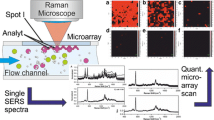Abstract
Surface chemistry is a crucial aspect for microarray modality biosensor development. The immobilization capability of the functionalized surface is indeed a limiting factor for the final yield of the binding reaction. In this work, we were able to simultaneously compare the functionality of protein ligands that were locally immobilized on different polymers, while on the same solid support, therefore demonstrating a new way of multiplexing. Our goal was to investigate, in a single experiment, both the immobilization efficiency of a group of reactive polymers and the resulting affinity of the tethered molecules. This idea was demonstrated by spotting many reactive polymers on a Si/SiO2 chip and depositing the molecular probes on the spots immediately after. As a proof of concept, we focused on which polymers would better immobilize a model protein (α-Lactalbumin) and a peptide (LAC-1). We successfully showed that this protocol is applicable to proteins and peptides with a good efficiency. By means of real-time binding measurements performed with the interferometric reflectance imaging sensor (IRIS), local functionalization proved to be comparable to the classical flat coating solution. The final outcome highlights the multiplexing power of this method: first, it allows to characterize dozens of polymers at once. Secondly, it removes the limitation, related to coated surfaces, that only molecules with the same functional groups can be tethered to the same solid support. By applying this protocol, many types of molecules can be studied simultaneously and immobilization for each probe can be individually optimized.






Similar content being viewed by others
References
MacBeath G. Protein microarrays and proteomics. Nat Genet. 2002;32(Suppl):526–32. https://doi.org/10.1038/ng1037.
Schena M, Shalon D, Davis RW, Brown PO. Quantitative monitoring of gene expression patterns with a complementary DNA microarray. Science. 1995;270:467–70. https://doi.org/10.1126/science.270.5235.467.
Pirri G, Damin F, Chiari M, Bontempi E, Depero LE. Characterization of a polymeric adsorbed coating for DNA microarray glass slides. Anal Chem. 2004;76:1352–8. https://doi.org/10.1021/ac0352629.
Sola L, Damin F, Gagni P, Consonni R, Chiari M. Synthesis of clickable coating polymers by post-polymerization modification: application in microarray technology. Langmuir. 2016;32:10284–95. https://doi.org/10.1021/acs.langmuir.6b02816.
Zilio C, Sola L, Damin F, Faggioni L, Chiari M. Universal hydrophilic coating of thermoplastic polymers currently used in microfluidics. Biomed Microdevices. 2014;16:107–14. https://doi.org/10.1007/s10544-013-9810-8.
Sola L, Damin F, Chiari M. Array of multifunctional polymers for localized immobilization of biomolecules on microarray substrates. Anal Chim Acta. 2019;1047:188–96. https://doi.org/10.1016/j.aca.2018.10.006.
Daaboul GG, Vedula RS, Ahn S, Lopez CA, Reddington A, Ozkumur E, et al. LED-based interferometric reflectance imaging sensor for quantitative dynamic monitoring of biomolecular interactions. Biosens Bioelectron. 2011;26:2221–7. https://doi.org/10.1016/j.bios.2010.09.038.
Mammen M, Dahmann G, Whitesides GM. Effective inhibitors of hemagglutination by influenza virus synthesized from polymers having active ester groups. Insight into mechanism of inhibition. J Med Chem. 1995;38:4179–90. https://doi.org/10.1021/jm00021a007.
Landi F, Johansson CM, Campopiano DJ, Hulme AN. Synthesis and application of a new cleavable linker for “click”-based affinity chromatography. Org Biomol Chem. 2010;8:56–9. https://doi.org/10.1039/b916693a.
Sola L, Chiari M. Modulation of electroosmotic flow in capillary electrophoresis using functional polymer coatings. J Chromatogr A. 2012;1270:324–9. https://doi.org/10.1016/j.chroma.2012.10.039.
Sola L, Damin F, Cretich M, Chiari M. Novel polymeric coatings with tailored hydrophobicity to control spot size and morphology in DNA microarray. Sensors Actuators B Chem. 2016;231:412–22. https://doi.org/10.1016/j.snb.2016.03.049.
Gori A, Cretich M, Vanna R, Sola L, Gagni P, Bruni G, et al. Multiple epitope presentation and surface density control enabled by chemoselective immobilization lead to enhanced performance in IgE-binding fingerprinting on peptide microarrays. Anal Chim Acta. 2017;983:189–97. https://doi.org/10.1016/j.aca.2017.06.027.
Needham J, Lortlar Ünlü N, Ünlü MS. Interferometric reflectance imaging sensor (IRIS) for molecular kinetics with a low-cost, disposable fluidic cartridge. In: Fitzgerald J, Fenniri H, editors. Biomimetic sensing. Methods in Molecular Biology, volume 2027. New York, NY: Humana; 2019. p. 15–28.
Sevenler D, Ünlü MS. Numerical techniques for high-throughput reflectance interference biosensing. J Mod Opt. 2016;63:1115–20. https://doi.org/10.1080/09500340.2015.1117668.
Chiari M, Cretich M, Damin F, Ceriotti L, Consonni R. New adsorbed coatings for capillary electrophoresis. Electrophoresis. 2000;21:909–16. https://doi.org/10.1002/(SICI)1522-2683(20000301)21:5<909::AID-ELPS909>3.0.CO;2-L.
Dommerholt J, Rutjes FPJT, van Delft FL. Strain-promoted 1,3-dipolar cycloaddition of cycloalkynes and organic azides. Top Curr Chem (Z). 2016;374:16. doi:10.1007/s41061-016-0016-4
Singh S, Dubinsky-Davidchika IS, Kluger R. Strain-promoted azide–alkyne cycloaddition for protein–protein coupling in the formation of a bis-hemoglobin as a copper-free oxygen carrier. Org Biomol Chem. 2016;14:10011–7. https://doi.org/10.1039/C6OB01817C.
Platt GW, Damin F, Swann MJ, Metton I, Skorski G, Cretich M, et al. Allergen immobilisation and signal amplification by quantum dots for use in a biosensor assay of IgE in serum. Biosens Bioelectron. 2014;52:82–8. https://doi.org/10.1016/j.bios.2013.08.019.
Pearson’s Correlation Coefficient. In: Encyclopedia of Public Health. Kirch W, editor. Springer, Dordrecht; 2008. doi:10.1007/978-1-4020-5614-7
Hochwallner H, Schulmeister U, Swoboda I, Focke-Tejkl M, Civaj V, Balic N, et al. Visualization of clustered IgE epitopes on α-lactalbumin. J Allergy Clin Immunol. 2010;125. https://doi.org/10.1016/j.jaci.2010.03.007.
Gori A, Sola L, Gagni P, Bruni G, Liprino M, Peri C, et al. Screening complex biological samples with peptide microarrays: the favorable impact of probe orientation via chemoselective immobilization strategies on clickable polymeric coatings. Bioconjug Chem. 2016;27:2669–77. https://doi.org/10.1021/acs.bioconjchem.6b00426.
Funding
This work was partially funded by Regione Lombardia, project AMANDA (Abnormal Metabolic states, cellular stressors and NeuroDegenerative processes).
Author information
Authors and Affiliations
Corresponding author
Ethics declarations
Conflict of interest
The authors declare that they have no conflict of interest.
All authors have participated in conception and design, or analysis and interpretation of the data; drafting the article or revising it critically for important intellectual content; and approval of the final version. This manuscript has not been submitted to, nor is under review at, another journal or publishing venue.
Additional information
Published in the topical collection Advances in Direct Optical Detection with guest editors Antje J. Baeumner, Günter Gauglitz and Jiri Homola.
Publisher’s note
Springer Nature remains neutral with regard to jurisdictional claims in published maps and institutional affiliations.
Electronic supplementary material
ESM 1
(PDF 99 mb)
Rights and permissions
About this article
Cite this article
Chiodi, E., Sola, L., Brambilla, D. et al. Simultaneous evaluation of multiple microarray surface chemistries through real-time interferometric imaging. Anal Bioanal Chem 412, 3477–3487 (2020). https://doi.org/10.1007/s00216-019-02276-1
Received:
Revised:
Accepted:
Published:
Issue Date:
DOI: https://doi.org/10.1007/s00216-019-02276-1




